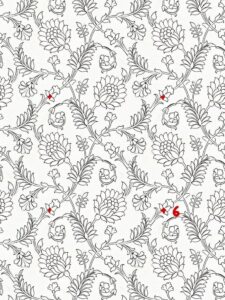Banarasi sarees are more than just a symbol of elegance and luxury. With their rich textures, intricate designs, and vibrant colours, they tell stories of heritage, culture, and deep-rooted symbolism. Each motif woven into the fabric carries hidden meanings, reflecting traditions, beliefs, and even life philosophies that have been passed down through generations. Let’s embark on a journey to decode the hidden symbolism in Banarasi saree motifs and explore how these artistic designs speak volumes about India’s cultural richness.
The Lotus: A Symbol of Purity and Spirituality

One of the most common and cherished motifs found in Banarasi sarees is the lotus. In Indian culture, the lotus represents purity, beauty, and spiritual enlightenment. Despite growing in muddy waters, the lotus blooms in perfection, symbolizing the ability to rise above adversity. This motif has deep connections with Hindu mythology, where the lotus is associated with divine figures like Goddess Lakshmi (goddess of wealth) and Lord Vishnu. Banarasi weavers often depict the lotus in intricate designs, celebrating its sacredness and beauty while imbuing the wearer with feelings of grace and poise.
The Peacock: A Celebration of Beauty and Royalty

The peacock is another widely recognized motif in Banarasi sarees, representing grace, beauty, and royalty. Revered as the national bird of India, the peacock is associated with regality and divine protection. In Indian mythology, the bird is often linked with deities like Saraswati (goddess of knowledge) and Kartikeya (god of war). The elaborate peacock motifs in Banarasi sarees are a nod to India’s royal past and embody the timeless appeal of luxury and elegance. Wearing a saree adorned with peacock motifs makes a statement of sophistication and timeless beauty.
Kalga and Bel: The Symbolism of Growth and Prosperity

The Kalga and Bel motifs, typically appearing as floral vines and paisleys, hold deep significance in Banarasi sarees. These designs often signify growth, fertility, and prosperity. Paisleys, which are teardrop-shaped motifs, originated in Persian art and made their way into Indian textiles through Mughal influence. They represent life and the cycle of regeneration, which reflects the continuity of tradition. The intertwining floral vines, known as Bel, echo nature’s bounty, symbolizing harmony, beauty, and the continuous flow of life.
The Jaal Design: Harmony and Unity

The Jaal design, characterized by interconnected patterns that cover the saree, is one of the most intricate and artistic motifs in Banarasi sarees. It symbolizes interconnectedness and unity in life. Each element in a Jaal motif is woven meticulously, creating a sense of balance and harmony. This design is often associated with abundance and eternal growth, making it a popular choice for bridal Banarasi sarees, which symbolize new beginnings and a hopeful future for the wearer.
The Elephant: Strength, Power, and Wisdom

The elephant motif, often seen on Banarasi sarees, signifies strength, power, and wisdom. In Indian culture, elephants hold a revered place, symbolizing divinity and kingship. Lord Ganesha, the remover of obstacles, is depicted with an elephant’s head, adding another layer of spiritual significance to this motif. In Banarasi sarees, the elephant motif represents dignity and steadfastness, reminding the wearer of their inner strength and wisdom.
Shikargah: A Depiction of Royal Hunts

One of the most unique motifs found in Banarasi sarees is the Shikargah, which features scenes of royal hunts. This motif dates back to the Mughal era when hunting was a royal pastime. Shikargah patterns depict animals like tigers, deer, and birds woven into complex scenes, showcasing the artistry of the weavers. These motifs symbolize valour, courage, and the thrill of adventure. Wearing a saree with a Shikargah design takes the wearer back in time to the grandeur of India’s royal courts.
Conclusion: A Cultural Tapestry Woven into Silk
The motifs found in Banarasi sarees are more than just decorative elements; they are threads that weave together the rich cultural history of India. Each symbol, whether it’s a lotus or a peacock, tells a story rooted in spirituality, mythology, and royalty. By understanding the hidden symbolism in these motifs, we gain deeper insight into the artistry and cultural heritage of Banarasi sarees. Wearing a Banarasi saree becomes not just a fashion statement, but a celebration of India’s timeless traditions and the craftsmanship of its weavers.

